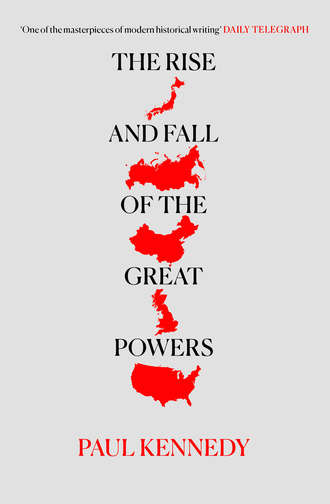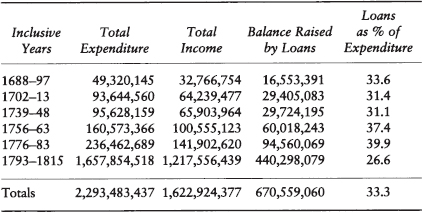
Полная версия
The Rise and Fall of the Great Powers
What is more important for the purposes of our argument is that in subscribing to foreign government loans, the Dutch were much less concerned about the religion or ideology of their clients than about their financial stability and reliability. Accordingly, the terms set for loans to European powers like Russia, Spain, Austria, Poland, and Sweden can be seen as a measure of their respective economic potential, the collateral they offered to the bankers, their record in repaying interest and premiums, and ultimately their prospects of emerging successfully from a Great Power war. Thus, the plummeting of Polish governmental stock in the late eighteenth century and, conversely, the remarkable – and frequently overlooked – strength of Austria’s credit for decade after decade mirrored the relative durability of those states.9
But the best example of this critical relationship between financial strength and power politics concerns the two greatest rivals of this period, Britain and France. Since the result of their conflict affected the entire European balance, it is worth examining their experiences at some length. The older notion that eighteenth-century Great Britain exhibited adamantine and inexorably growing commercial and industrial strength, unshakable fiscal credit, and a flexible, upwardly mobile social structure – as compared with an ancien régime France founded upon the precarious sands of military hubris, economic backwardness, and a rigid class system – seems no longer tenable. In some ways, the French taxation system was less regressive than the British. In some ways, too, France’s economy in the eighteenth century was showing signs of movement toward ‘takeoff’ into an industrial revolution, even though it had only limited stocks of such a critical item as coal. Its armaments production was considerable, and it possessed many skilled artisans and some impressive entrepreneurs.10 With its far larger population and more extensive agriculture, France was much wealthier than its island neighbour; the revenues of its government and the size of its army dwarfed those of any western European rival; and its dirigiste regime, as compared with the party-based politics of Westminster, seemed to give it a greater coherence and predictability. In consequence, eighteenth-century Britons were much more aware of their own country’s relative weaknesses than its strengths when they gazed across the Channel.
For all this, the English system possessed key advantages in the financial realm which enhanced the country’s power in wartime and buttressed its political stability and economic growth in peacetime. While it is true that its general taxation system was more regressive than that of France – that is, relied far more upon indirect than direct taxes – particular features seem to have made it much less resented by the public. For example, there was in Britain nothing like the vast array of French tax farmers, collectors, and other middlemen; many of the British duties were ‘invisible’ (the excise duty on a few basic products), or appeared to hurt the foreigner (customs): there were no internal tolls, which so irritated French merchants and were a disincentive to domestic commerce; the British land tax – the chief direct tax for so much of the eighteenth century – allowed for no privileged exceptions and was also ‘invisible’ to the greater part of society; and these various taxes were discussed and then authorized by an elective assembly, which for all its defects appeared more representative than the ancien régime in France. When one adds to this the important point that per capita income was already somewhat higher in Britain than in France even by 1700, it is not altogether surprising that the population of the island state was willing and able to pay proportionately larger taxes. Finally, it is possible to argue – although more difficult to prove statistically – that the comparatively light burden of direct taxation in Britain not only increased the propensity to save among the better-off society (and thus allowed the accumulation of investment capital during years of peace), but also produced a vast reserve of taxable wealth in wartime, when higher land taxes and, in 1799, direct income tax were introduced to meet the national emergency. Thus, by the period of the Napoleonic War, despite a population less than half that of France, Britain was for the first time ever raising more revenue from taxes each year in absolute terms than its larger neighbour.11
Yet however remarkable that achievement, it is eclipsed in importance by the even more significant difference between the British and French systems of public credit. For the fact was that during most of the eighteenth-century conflicts, almost three-quarters of the extra finance raised to support the additional wartime expenditures came from loans. Here, more than anywhere else, the British advantages were decisive. The first was the evolution of an institutional framework which permitted the raising of long-term loans in an efficient fashion and simultaneously arranged for the regular repayment of the interest on (and principal of) the debts accrued. The creation of the Bank of England in 1694 (at first as a wartime expedient) and the slightly later regularization of the national debt on the one hand and the flourishing of the stock exchange and growth of the ‘country banks’ on the other boosted the supply of money available to both governments and businessmen. This growth of paper money in various forms without severe inflation or the loss of credit brought many advantages in an age starved of coin. Yet the ‘financial revolution’ itself would scarcely have succeeded had not the obligations of the state been guaranteed by successive Parliaments with their powers to raise additional taxes; had not the ministries – from Walpole to the younger Pitt – worked hard to convince their bankers in particular and the public in general that they, too, were actuated by the principles of financial rectitude and ‘economical’ government; and had not the steady and in some trades remarkable expansion of commerce and industry provided concomitant increases in revenue from customs and excise. Even the onset of war did not check such increases, provided the Royal Navy protected the nation’s overseas trade while throttling that of its foes. It was upon these solid foundations that Britain’s ‘credit’ rested, despite early uncertainties, considerable political opposition, and a financial near-disaster like the collapse of the famous South Seas Bubble of 1720. ‘Despite all defects in the handling of English public finance,’ its historian had noted, ‘for the rest of the century it remained more honest, as well as more efficient, than that of any other in Europe.12
The result of all this was not only that interest rates steadily dropped,* but also that British government stock was increasingly attractive to foreign, and particularly Dutch, investors. Regular dealings in these securities on the Amsterdam market thus became an important part of the nexus of Anglo-Dutch commercial and financial relationships, with important effects upon the economies of both countries.13 In power-political terms, its value lay in the way in which the resources of the United Provinces repeatedly came to the aid of the British war effort, even when the Dutch alliance in the struggle against France had been replaced by an uneasy neutrality. Only at the time of the American Revolutionary War – significantly, the one conflict in which British military, naval, diplomatic, and trading weaknesses were most evident, and therefore its creditworthiness was the lowest – did the flow of Dutch funds tend to dry up, despite the higher interest rates which London was prepared to offer. By 1780, however, when the Dutch entered the war on France’s side, the British government found that the strength of its own economy and the availability of domestic capital were such that its loans could be almost completely taken up by domestic investors.
The sheer dimensions – and ultimate success – of Britain’s capacity to raise war loans can be summarized as in Table 2. And the strategical consequence of these figures was that the country was thereby enabled ‘to spend on war out of all proportion to its tax revenue, and thus to throw into the struggle with France and its allies the decisive margin of ships and men without which the resources previously committed might have been committed in vain’.14 Although many British commentators throughout the eighteenth century trembled at the sheer size of the national debt and its possible consequences, the fact remained that (in Bishop Berkeley’s words) credit was the ‘principal advantage that England hath over France’. Finally, the great growth in state expenditures and the enormous, sustained demand which Admiralty contracts in particular created for iron, wood, cloth, and other wares produced a ‘feedback loop’ which assisted British industrial production and stimulated the series of technological breakthroughs that gave the country yet another advantage over the French.15
TABLE 2. British Wartime Expenditure and Revenue, 1688–1815
(pounds)

Why the French failed to match these British habits is now easy to see.16 There was, to begin with, no proper system of public finance. From the Middle Ages onward, the French monarchy’s financial operations had been ‘managed’ by a cluster of bodies – municipal governments, the clergy, provincial estates, and, increasingly, tax farmers – which collected the revenues and supervised the monopolies of the crown in return for a portion of the proceeds, and which simultaneously advanced monies to the French government – at handsome rates of interest – on the expected income from these operations. The venality of this system applied not only to the farmers general who gathered in the tobacco and salt dues; it was also true of that hierarchy of parish collectors, district receivers, and regional receivers general responsible for direct taxes like the taille. Each of them took his ‘cut’ before passing the monies on to a higher level; each of them also received 5 per cent interest on the price he paid for office in the first place; and many of the more senior officials were charged with paying out sums directly to government contractors or as wages, without first handing their takings in to the royal treasury. These men, too, loaned funds – at interest – to the crown.
Such a lax and haphazard organization was inherently corrupt, and much of the taxpayers’ monies ended in private hands. On occasions, especially after wars, investigations would be launched against financiers, many of whom were induced to pay ‘compensation’ or accept lower interest rates; but such actions were mere gestures. ‘The real culprit’, one historian has argued, ‘was the system itself.’17 The second consequence of this inefficiency was that at least until Necker’s reforms of the 1770s, there existed no overall sense of national accounting; annual tallies of revenue and expenditure, and the problem of deficits, were rarely thought to be of significance. Provided the monarch could raise funds for the immediate needs of the military and the court, the steady escalation of the national debt was of little import.
While a similar sort of irresponsibility had earlier been shown by the Stuarts, the fact was that by the eighteenth century Britain had evolved a parliamentary-controlled form of public finance which gave it numerous advantages in the duel for primacy. Not the least of these seems to have been that while the rise in government spending and in the national debt did not hurt (and may indeed have boosted) British investment in commerce and industry, the prevailing conditions in France seem to have encouraged those with surplus capital to purchase an office or an annuity rather than to invest in business. On some occasions, it was true, there were attempts to provide France with a national bank, so that the debt could be properly managed and cheap credit provided; but such schemes were always resisted by those with an interest in the existing system. The French government’s financial policy, if indeed it deserves that name, was therefore always a hand-to-mouth affair.
France’s commercial development also suffered in a number of ways. It is interesting to note, for example, the disadvantages under which a French port like La Rochelle operated compared with Liverpool or Glasgow. All three were poised to exploit the booming ‘Atlantic economy’ of the eighteenth century, and La Rochelle was particularly well sited for the triangular trade to West Africa and the West Indies. Alas for such mercantile aspirations, the French port suffered from the repeated depredations of the crown, ‘insatiable in its fiscal demands, unrelenting in its search for new and larger sources of revenue’. A vast array of ‘heavy, inequitable and arbitrarily levied direct and indirect taxes on commerce’ retarded economic growth; the sale of offices diverted local capital from investment in trade, and the fees levied by those venal officeholders intensified that trend; monopolistic companies restricted free enterprise. Moreover, although the crown compelled the Rochelais to build a large and expensive arsenal in the 1760s (or have the city’s entire revenues seized!), it did not offer a quid pro quo when wars occurred. Because the French government usually concentrated upon military rather than maritime aims, the frequent conflicts with a superior Royal Navy were a disaster for La Rochelle, which saw its merchant ships seized, its profitable slave trade interrupted, and its overseas markets in Canada and Louisiana eliminated – all at a time when marine insurance rates were rocketing and emergency taxes were being imposed. As a final blow, the French government often felt compelled to allow its overseas colonists to trade with neutral shipping in wartime, but this made those markets ever more difficult to recover when peace was concluded. By comparison, the Atlantic sector of the British economy grew steadily throughout the eighteenth century, and if anything benefited in wartime (despite the attacks of French privateers) from the policies of a government which held that profit and power, trade and dominion, were inseparable.18
The worst consequence of France’s financial immaturity was that in time of war its military and naval effort was eroded, in a number of ways.19 Because of the inefficiency and unreliability of the system, it took longer to secure the supply of (say) naval stores, while contractors usually needed to charge more than would be the case with the British or Dutch admiralties. Raising large sums in wartime was always more of a problem for the French monarchy, even when it drew increasingly upon Dutch money in the 1770s and 1780s, for its long history of currency revaluations, its partial repudiations of debt, and its other arbitrary actions against the holders of short-term and long-term bills caused bankers to demand – and a desperate French state to agree to – rates of interest far above those charged to the British and many other European governments.* Yet even this willingness to pay over the odds did not permit the Bourbon monarchs to secure the sums which were necessary to sustain an all-out military effort in a lengthy war.
The best illustration of this relative French weakness occurred in the years following the American Revolutionary War. It had hardly been a glorious conflict for the British, who had lost their largest colony and seen their national debt rise to about £220 million; but since those sums had chiefly been borrowed at a mere 3 per cent interest, the annual repayments totalled only £7.33 million. The actual costs of the war to France were considerably smaller; after all, it had entered the conflict at the halfway stage, following Necker’s efforts to balance the budget, and for once it had not needed to deploy a massive army. Nonetheless, the war cost the French government at least a billion livres, virtually all of which was paid by floating loans at rates of interest at least double that available to the British government. In both countries, servicing the debt consumed half the state’s annual expenditures, but after 1783 the British immediately embarked upon a series of measures (the Sinking Fund, a consolidated revenue fund, improved public accounts) in order to stabilize that total and strengthen its credit – the greatest, perhaps, of the younger Pitt’s achievements. On the French side, by contrast, large new loans were floated each year, since ‘normal’ revenues could never match even peacetime expenditures; and with yearly deficits growing, the government’s credit weakened still further.
The startling statistical consequence was that by the late 1780s France’s national debt may have been almost the same as Britain’s – around £215 million – but the interest payments each year were nearly double, at £14 million. Still worse, the efforts of succeeding finance ministers to raise fresh taxes met with stiffening public resistance. It was, after all, Calonne’s proposed tax reforms, leading to the Assembly of Notables, the moves against the parlements, the suspension of payments by the treasury, and then (for the first time since 1614) the calling of the States General in 1789 which triggered off the final collapse of the ancien régime in France.20 The link between national bankruptcy and revolution was all too clear. In the desperate circumstances which followed, the government issued ever more notes (to the value of 100 million livres in 1789, and 200 million in 1790), a device replaced by the Constituent Assembly’s own expedient of seizing church lands and issuing paper money on their estimated worth. All this led to further inflation, which the 1792 decision for war only exacerbated. And while it is true that later administrative reforms within the treasury itself and the revolutionary regime’s determination to know the true state of affairs steadily produced a unified, bureaucratic, revenue-collecting structure akin to those existing in Britain and elsewhere, the internal convulsions and external overextension that were to last until 1815 caused the French economy to fall even further behind that of its greatest rival.
This problem of raising revenue to pay for current – and previous – wars preoccupied all regimes and their statesmen. Even in peacetime, the upkeep of the armed services consumed 40 or 50 per cent of a country’s expenditures; in wartime, it could rise to 80 or even 90 per cent of the far larger whole! Whatever their internal constitutions, therefore, autocratic empires, limited monarchies, and bourgeois republics throughout Europe faced the same difficulty. After each bout of fighting (and especially after 1714 and 1763), most countries desperately needed to draw breath, to recover from their economic exhaustion, and to grapple with the internal discontents which war and higher taxation had all too often provoked; but the competitive, egoistic nature of the European states system meant that prolonged peace was unusual and that within another few years preparations were being made for further campaigning. Yet if the financial burdens could hardly be carried by the French, Dutch, and British, the three richest peoples of Europe, how could they be borne by far poorer states?
The simple answer to this question was that they couldn’t. Even Frederick the Great’s Prussia, which drew much of its revenues from the extensive, well-husbanded royal domains and monopolies, could not meet the demands of the War of the Austrian Succession and Seven Years War without recourse to three ‘extraordinary’ sources of income: profits from debasement of the coinage; plunder from neighbouring states such as Saxony and Mecklenburg; and, after 1757, considerable subsidies from its richer ally, Britain. For the less efficient and more decentralized Habsburg Empire, the problems of paying for war were immense; but it is difficult to believe that the situation was any better in Russia or in Spain, where the prospects for raising monies – other than by further squeezes upon the peasantry and the underdeveloped middle classes – were not promising. With so many orders (e.g. Hungarian nobility, Spanish clergy) claiming exemptions under the anciens régimes, even the invention of elaborate indirect taxes, debasements of the currency, and the printing of paper money were hardly sufficient to maintain the elaborate armies and courts in peacetime; and while the onset of war led to extraordinary fiscal measures for the national emergency, it also meant that increasing reliance had to be placed upon the western European money markets or, better still, direct subsidies from London, Amsterdam, or Paris which could then be used to buy mercenaries and supplies. Pas d’argent, pas de Suisses may have been a slogan for Renaissance princes, but it was still an unavoidable fact of life even in Frederician and Napoleonic times.21
This is not to say, however, that the financial element always determined the fate of nations in these eighteenth-century wars. Amsterdam was for much of this period the greatest financial centre of the world, yet that alone could not prevent the United Provinces’ demise as a leading power; conversely, Russia was economically backward and its government relatively starved of capital, yet the country’s influence and might in European affairs grew steadily. To explain that seeming discrepancy, it is necessary to give equal attention to the second important conditioning factor, the influence of geography upon national strategy.
Geopolitics
Because of the inherently competitive nature of European power politics and volatility of alliance relationships throughout the eighteenth century, rival states often encountered remarkably different circumstances – and sometimes extreme variations of fortune – from one major conflict to the next. Secret treaties and ‘diplomatic revolutions’ produced changing conglomerations of powers, and in consequence fairly frequent shifts in the European equilibrium, both military and naval. While this naturally caused great reliance to be placed upon the expertise of a nation’s diplomats, not to mention the efficiency of its armed forces, it also pointed to the significance of the geographical factor. What is meant by that term is not merely such elements as a country’s climate, raw materials, fertility of agriculture, and access to trade routes – important though they all were to its overall prosperity – but rather the critical issue of strategical location during these multilateral wars. Was a particular nation able to concentrate its energies upon one front, or did it have to fight on several? Did it share common borders with weak states, or powerful ones? Was it chiefly a land power, a sea power, or a hybrid – and what advantages and disadvantages did that bring? Could it easily pull out of a great war in central Europe if it wished to? Could it secure additional resources from overseas?
The fate of the United Provinces in this period provides a good example of the influences of geography upon politics. In the early seventeenth century it possessed many of the domestic ingredients for national growth – a flourishing economy, social stability, a well-trained army, and a powerful navy; and it had not then seemed disadvantaged by geography. On the contrary, its river network provided a barrier (at least to some extent) against Spanish forces, and its North Sea position gave it easy access to the rich herring fisheries. But a century later, the Dutch were struggling to hold their own against a number of rivals. The adoption of mercantilist policies by Cromwell’s England and Colbert’s France hurt Dutch commerce and shipping. For all the tactical brilliance of commanders like Tromp and de Ruyter, Dutch merchantmen in the naval wars against England had either to run the gauntlet of the Channel route or to take the longer and stormier route around Scotland, which (like their herring fisheries) was still open to attack in the North Sea; the prevailing westerly winds gave the battle advantage to the English admirals; and the shallow waters off Holland restricted the draught – and ultimately the size and power – of the Dutch warships.22 In the same way as its trade with the Americas and Indies became increasingly exposed to the workings of British sea power, so, too, was its Baltic entrepôt commerce – one of the very foundations of its early prosperity – eroded by the Swedes and other local rivals. Although the Dutch might temporarily reassert themselves by the dispatch of a large battle fleet to a threatened point, there was no way in which they could permanently preserve their extended and vulnerable interests in distant seas.





